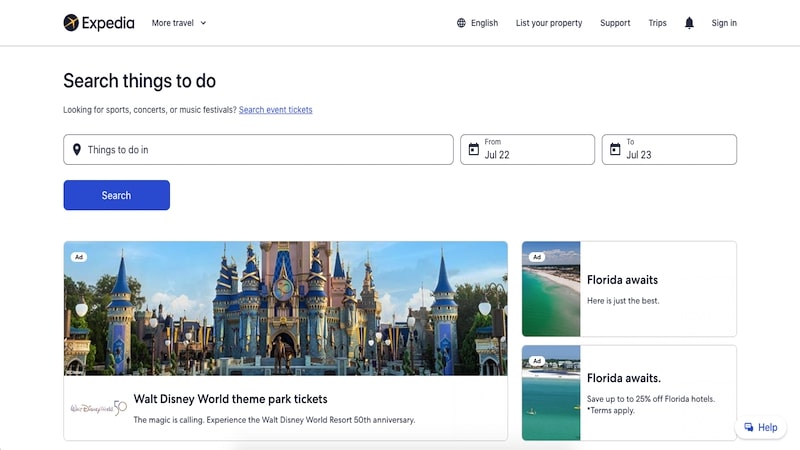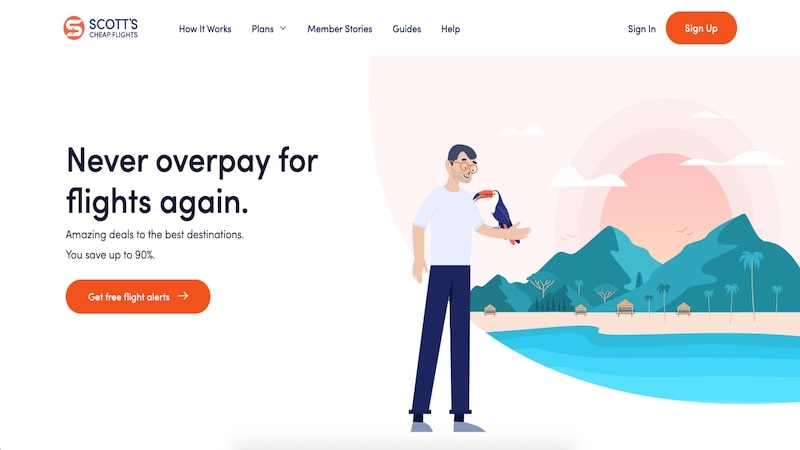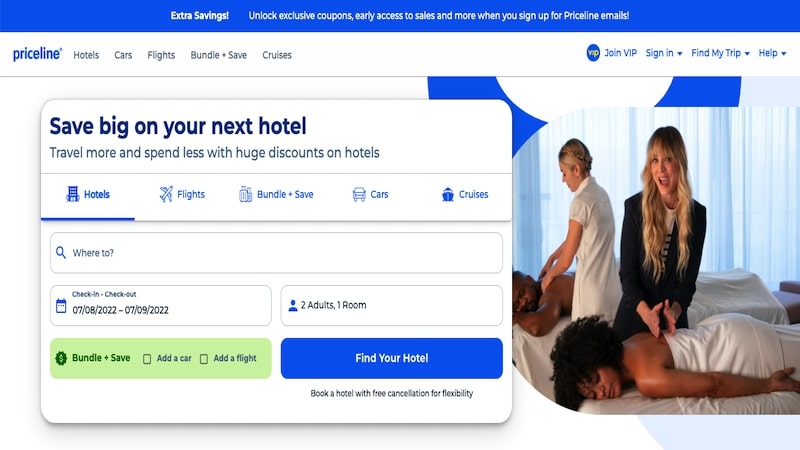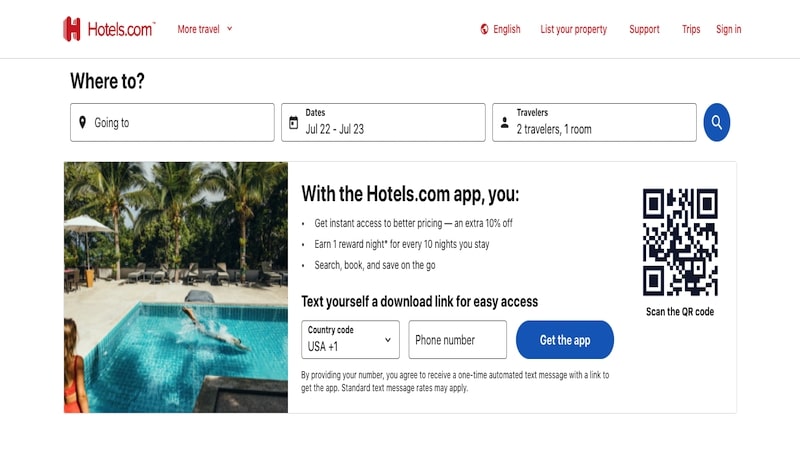12 Best Discount Travel Websites
Some products in this article are from our partners. Read our Advertiser Discloser.
Are you using the best discount travel websites to save when you travel? Lots of people like traveling, but nobody likes how much it costs to travel.
Between flights and hotels, it can feel like there’s barely any money left to have fun when you get to your destination.
Many services and websites offer a discount on travel purchases, including hotels, airfare and rental cars.
Just because these websites are called discount travel websites doesn’t mean they’re low-quality.
Many of these sites offer the same great travel experiences that you’d get by booking direct but at a lower cost.
By helping hotels fill last-minute vacancies or highlighting promotions, these discount travel websites can help you experience luxury travel at a reduced price.
Top Discount Travel Websites
If discount travel is your goal, there are dozens of websites that can help you save money. Here are the best options.
1. Expedia

Expedia offers booking services that let you find flights, hotels, cruises, rental cars and vacation bundles.
The thing that sets Expedia apart is its rewards program. When you sign up, you automatically receive a few perks, including discounts and additional amenities at select hotels.
You’ll also earn two rewards points for every dollar spent on hotels, cars, packages, tours and cruises.
Plus, one point for every $5 spent on flights. You can redeem every 140 points that you earn for $1 off your next trip.
2. Kayak
Kayak is a travel deal aggregator. When you search for a trip on Kayak, its search engine checks hundreds of travel websites.
Kayak helps you find the best available deal, whether it comes directly from their company or one of its competitors.
You can search for deals on:
- Hotels
- Flights
- Cruises
- Rental cars
- Restaurants
- Full vacation packages
3. Scott’s Cheap Flights

Scott’s Cheap Flights is slightly different from traditional travel websites.
Instead of letting you search for specific flights and dates, Scott’s Cheap Flights offers an email list. You can sign up for free, though premium members get more frequent emails.
Scott’s Cheap Flights uses a web search and monitoring software to track flight prices and significant changes.
When it detects a major change, the website sends out an email to members with information about the available routes, the price and an estimate for how long the price will last.
Usually, you’ll have a couple of days to book.
A recent example is round trip flights to London from the United States. Usually, the cost of such a trip is more than $1,000.
American, Delta and AirFrance had a temporary price cut that dropped the cost to less than $600 from most areas and under $400 from some locations.
Scott’s Cheap Flights requires a bit more flexibility in planning both the timing and destination for your trips.
However, if you take advantage of one of the site’s deals, you can save 40-90% on flights.
4. TripAdvisor
TripAdvisor combines travel booking with reviews to create an all-in-one travel website. You can use the site to book hotels, flights, cruises, restaurant reservations and tours.
While you’re booking, you can read other customers’ reviews to make sure you’re booking an experience you’ll enjoy.
TripAdvisor also offers a powerful app that makes it a great tool to use after you’ve booked your trip.
You can look up local landmarks and experiences through the app to plan your day while on vacation.
5. Booking.com
Booking.com is one of the most popular travel websites on the internet.
It offers discounts on flights, hotels, rental cars and even tours and activities once you get to your final destination.
The site also offers package discounts when you book your flight and hotel at the same time.
If you live in a popular travel destination, Booking.com lets you list your home or apartment for rent.
You can use the service to rent your place out while you’re on a trip to make a bit of money or defray the cost of your vacation.
6. Priceline

Priceline is a relatively basic travel website. Enter the details of where you want to go and when and Priceline will find multiple options for you.
You can use the site to book flights, hotels, cruises, and rental cars.
The savings opportunities come from Priceline’s Bundle and Save feature, which lets you book flights and hotels together.
The site also offers Express Deals. These deals give you a discount rate on hotels, but you don’t get to see the details of the hotel until after you book.
All you’ll get to see is the star rating, amenities and nightly rate.
This deal can be nice for people who are flexible about where they stay but won’t work if you have to stay in a specific part of town.
7. Hotwire
Hotwire is another travel website where bundling is the thing that will save you money. You can search for flights, hotels and rental cars through the site.
But you won’t pay much less than you would be booking directly without bundling.
If you do bundle your flight and hotel, you can find a good deal.
Hotwire also highlights what it calls “Hot Rate Flights.” Like Priceline’s Express Deals, these flights don’t show you the exact details, like the airline or number of stops, but they’ll get you where you’re going at a lower cost.
If you’re flexible about departure and arrival times, these deals can be worth taking.
8. Orbitz
Orbitz is another online travel agency with its own rewards program.
If you use Orbitz frequently, you can build up a balance of rewards points, called Orbucks, and save on your next booking.
Orbitz offers 5% back in Orbucks when you book your hotel stay through the Orbitz app and 3% back when you book a hotel on a computer.
Flights and vacation packages net you 1% back in Orbucks.
Orbitz also offers a credit card and a dining program that you can use to earn even more rewards.
Just keep in mind that you can only use your Orbucks to book hotel stays. Flights and vacation packages are not eligible.
9. Hotels.com

Hotels.com is, as its name implies, all about booking hotels. The site does have a section for booking flights and travel packages, but hotels are where it shines.
The website offers daily deals on different hotels, with prices up to 50% lower than average. It has regularly changing app-exclusive deals as well.
Last-minute travelers can also take advantage of the site’s last-minute deals, which offer cut-rate hotel stays when you book right before you leave.
Like some other travel sites, Hotels.com offers a rewards program. You’ll earn a reward after you stay for ten total nights at hotels booked through Hotels.com.
Your reward is worth the average cost of the ten nights, and you can redeem it at more than half a million locations.
10. Google Flights
Google Flights is a simple site that lets you search for airfare between any two destinations.
Google automatically searches carriers’ websites and shows you the best flights to get you from point A to point B.
Where Google Flights shines is its ability to track prices and make it easy for you to find a deal. You can pull up a price grid once you search for your desired flight.
The grid shows the cheapest available flights for every combination of departure and return dates that are close to your original search.
If you can be flexible about when you fly, this can help you save a lot of money.
Google Flights also lets you track flight prices for different routes. Ask the site to track a flight for you, and you’ll get automatic alerts for price changes or sales.
Like most other travel sites, Google FLights offers the option to book hotel stays and full vacation packages.
11. Jetsetter
Jetsetter is an online travel magazine that also offers booking services to help you get a deal on hotels.
The biggest savings opportunity comes from the website’s flash sales.
They’re short-lived, but if you hop on one of these deals, you can save 50% or more off of the hotel’s nightly rate.
If you like reading about travel and have some flexibility about where you take your next trip, these flash deals can be worth watching.
12. Travelocity
Travelocity is another well-known online travel agency. Like the other major travel websites, it helps you book flights, hotels, rental cars, cruises and full vacation packages.
It also offers a membership service that you can sign up for to save up to 10% when staying at participating hotels.
Travelocity regularly posts special member deals as well as public sales. So it’s worth keeping an eye on the site to see if you can find a deal on a destination you’d like to visit.
Tricks for Using a Discount Travel Website
Using a discount travel website is just one part of saving money on your next vacation.
There are a few tricks that you can use to save even more when you book a flight or hotel online.
Use a Shopping Portal
Many travel websites partner with shopping portals like Rakuten or Mr. Rebates. Shopping portals are websites that pay you when you use them to shop.
All you have to do is visit the shopping portal, click through to the travel site you plan to book from and then book your travel as usual.
The shopping portal tracks your purchase and automatically rewards you based on the amount that you spend.
There’s no cost to use a shopping portal, and the price you pay won’t change, so using a shopping portal is like getting free money.
You should use one whenever you book travel or shop anywhere else online.
Check Back Regularly
Travel pricing is complicated. Airlines and hotel chains change prices all the time.
You might check the price of a flight and see it costs $300 one day only for it to cost $250 the next and $325 a week later.
Once you book your travel plans, keep checking back with the travel site regularly to see if prices change.
If the price falls below the price you paid, you might be able to save even more money.
Some travel sites will automatically refund the difference if you ask. Others offer fee-free cancellations, making it easy to cancel and rebook at a lower rate.
Check the fine print of the website that you use for the details on how you can get your money back if prices fall after you book.
Use a travel credit card
Just because you’re saving money when you book doesn’t mean that you can’t save even more money. When you pay for your trip on the travel site, use a travel rewards credit card.
These cards let you earn airline miles and hotel points that you can later redeem for free flights and hotel stays.
Earning rewards can also help you acquire premium status with airlines and hotel chains. Status offers premium perks like room upgrades, priority boarding and free breakfasts.
You’d usually have to pay for these perks, but you can get them for free with status.
Some cards also get you a certain amount of fee rebates each year or let you check a bag for free.
Every fee you can avoid is money you’re saving on travel, making these cards well worth getting.
Summary
Everyone enjoys vacations, and travel is a great way to experience new places and different cultures.
However, the problem with travel is that it can be incredibly expensive, especially if you want to visit another country or somewhere far away.
Discount travel websites can help you save money when you book travel.
Plus, they give you useful tips about things to do, making them an essential part of planning for your next trip.

